 Search by Keyword
|
“GOOD DAY SUNSHINE”
(John Lennon – Paul McCartney)
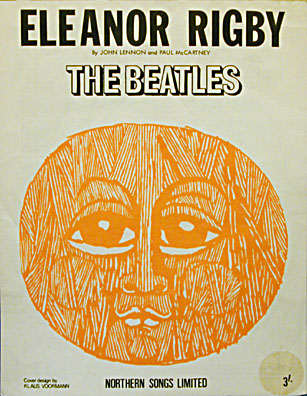 The Beatles’ 1966 masterpiece “Revolver” is known for its darker subject matter and feel. In comparison to the mostly happy-go-lucky atmosphere of their previous three years, primary tracks on this album tell of the death of a lonely spinster (“Eleanor Rigby”), the evil greed of the government (“Taxman”) and the contemplation of “what it’s like to be dead” (“She Said She Said”), not to mention other less than cheery subjects. Half of the album's songs contained on the British version of the album, in fact, include a form of the word “die” or “dead” in the lyrics. (See if you can identify these seven songs – maybe you can include this question when you have your next Beatles trivia party!) The Beatles’ 1966 masterpiece “Revolver” is known for its darker subject matter and feel. In comparison to the mostly happy-go-lucky atmosphere of their previous three years, primary tracks on this album tell of the death of a lonely spinster (“Eleanor Rigby”), the evil greed of the government (“Taxman”) and the contemplation of “what it’s like to be dead” (“She Said She Said”), not to mention other less than cheery subjects. Half of the album's songs contained on the British version of the album, in fact, include a form of the word “die” or “dead” in the lyrics. (See if you can identify these seven songs – maybe you can include this question when you have your next Beatles trivia party!)
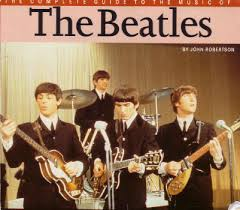 This is not to say that the group was all "doom and gloom" at this point. Their experimentation with drugs, their disillusionment with touring, and their early experience with Eastern music and culture have all been pointed to by many as explanations for this change in lyrical tone, but this is not to say that The Beatles were finding no natural joy in life. The most vivid case in point here is a song that author John Robertson describes in his book “The Complete Guide To The Music Of The Beatles” as “perfect summer pop for the era…the ideal complement to the darker ‘Revolver’ songs.” This is not to say that the group was all "doom and gloom" at this point. Their experimentation with drugs, their disillusionment with touring, and their early experience with Eastern music and culture have all been pointed to by many as explanations for this change in lyrical tone, but this is not to say that The Beatles were finding no natural joy in life. The most vivid case in point here is a song that author John Robertson describes in his book “The Complete Guide To The Music Of The Beatles” as “perfect summer pop for the era…the ideal complement to the darker ‘Revolver’ songs.”
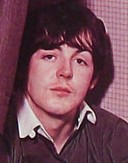 This song, “Good Day Sunshine,” was chosen to open side two of the album undoubtedly to pick up the level of positivity and create an artistic contrast within the framework contained on the LP. While it was true that Paul was the last holdout of the group to experiencing the “higher awareness” of acid at this point, he apparently still chose to get his high from taking an innocent walk in the park with his girl on a “sunny day,” as depicted in this track. Sounds pretty good to me. This song, “Good Day Sunshine,” was chosen to open side two of the album undoubtedly to pick up the level of positivity and create an artistic contrast within the framework contained on the LP. While it was true that Paul was the last holdout of the group to experiencing the “higher awareness” of acid at this point, he apparently still chose to get his high from taking an innocent walk in the park with his girl on a “sunny day,” as depicted in this track. Sounds pretty good to me.
Songwriting History
“’Good Day Sunshine’ is Paul’s. Maybe I threw in a line or something, I don’t know” This quote from John Lennon from his 1980 Playboy interview is essentially the same as his quote about the song in his 1972 interview with Hit Parader magazine.
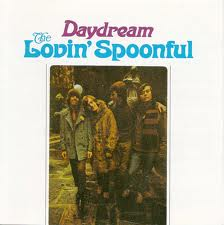 “Wrote that out at John’s one day…the sun was shining,” McCartney remembered in 1984, adding: “influenced by The Lovin’ Spoonful.” He elaborates further in his 1997 book “Many Years From Now”: "It was really very much a nod to The Lovin’ Spoonful’s ‘Daydream,’ the same traditional, almost trad-jazz feel. That was our favorite record of theirs. ‘Good Day Sunshine’ was me trying to write something very similar to ‘Daydream.’ John and I wrote it together at Kenwood, but it was basically mine, and he helped me with it." “Wrote that out at John’s one day…the sun was shining,” McCartney remembered in 1984, adding: “influenced by The Lovin’ Spoonful.” He elaborates further in his 1997 book “Many Years From Now”: "It was really very much a nod to The Lovin’ Spoonful’s ‘Daydream,’ the same traditional, almost trad-jazz feel. That was our favorite record of theirs. ‘Good Day Sunshine’ was me trying to write something very similar to ‘Daydream.’ John and I wrote it together at Kenwood, but it was basically mine, and he helped me with it."
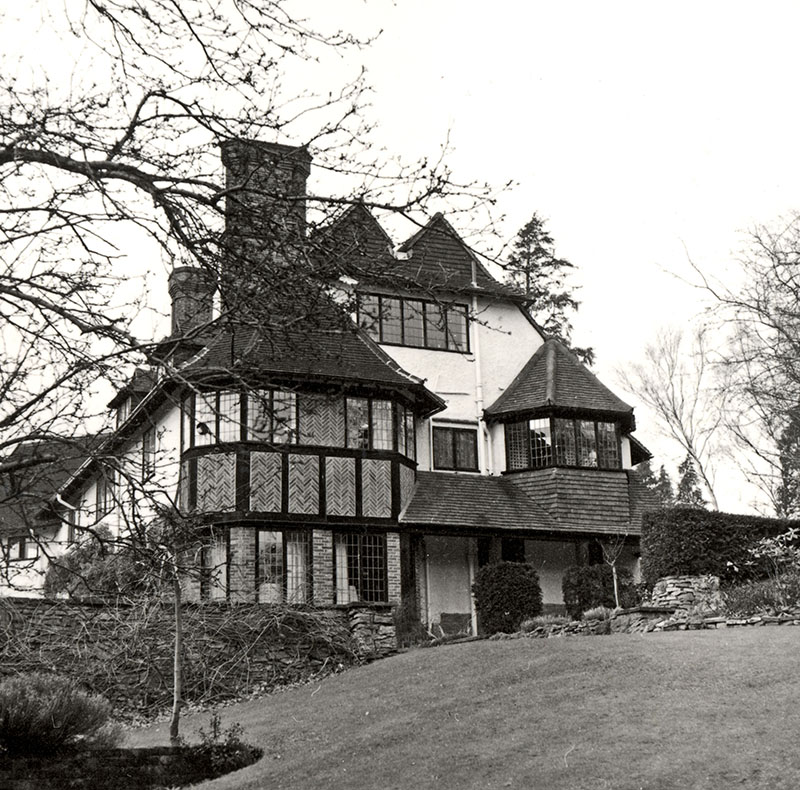 Paul goes into even greater detail in his 2021 book "The Lyrics." "Once again, I was out at John's house in Weybridge. I'd driven myself there from my home in London in my beautiful sierra-blue Aston Martin, ejector seat and all. I love to drive, and an hour's drive is a good time to think of things; if you've got half an idea, you can flesh it out on the way. I would often arrive at John's place with a fully formed idea. Sometimes I would have to wait, if John was late getting up; he was a lazy bastard, whereas I was a very enthusiastic young man. Mind you, if I did have to wait there was a little swimming pool I could sit beside." Paul goes into even greater detail in his 2021 book "The Lyrics." "Once again, I was out at John's house in Weybridge. I'd driven myself there from my home in London in my beautiful sierra-blue Aston Martin, ejector seat and all. I love to drive, and an hour's drive is a good time to think of things; if you've got half an idea, you can flesh it out on the way. I would often arrive at John's place with a fully formed idea. Sometimes I would have to wait, if John was late getting up; he was a lazy bastard, whereas I was a very enthusiastic young man. Mind you, if I did have to wait there was a little swimming pool I could sit beside."
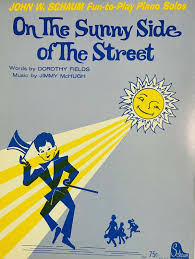 "Around that time there was quite a spate of summer songs. 'Daydream' and 'Summer In The City' by The Lovin' Spoonful, The Kinks' 'Sunny Afternoon'...We wanted to write something sunny. Both John and I had grown up while the music hall tradition was still very vibrant, so it was always in the back of our minds. There are lots of songs about the sun, and they make you happy: 'The Sun Has Got His Hat On' or 'On The Sunny Side Of The Street.' It was now time for us to do ours. So we've got love and sun, what more do we want?" "Around that time there was quite a spate of summer songs. 'Daydream' and 'Summer In The City' by The Lovin' Spoonful, The Kinks' 'Sunny Afternoon'...We wanted to write something sunny. Both John and I had grown up while the music hall tradition was still very vibrant, so it was always in the back of our minds. There are lots of songs about the sun, and they make you happy: 'The Sun Has Got His Hat On' or 'On The Sunny Side Of The Street.' It was now time for us to do ours. So we've got love and sun, what more do we want?"
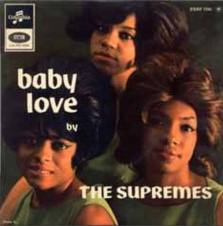 The “trad-jazz feel” of the song "Daydream" that McCartney mentions above was actually inspired by another major influence on the group, namely the “Motown Sound.” However, he was not aware that this particular influence crept into “Good Day Sunshine.” In Steve Turner's book "A Hard Day's Write," Lovin’ Spoonful songwriter John Sebastian states: “I said, we gotta have a tune like ‘Baby Love’ (by Motown's “The Supremes”). I wrote the song while trying to approximate the ‘Baby Love’ feel on one guitar. Sometimes you attempt to cop something and what you come up with is something very much your own.” The “trad-jazz feel” of the song "Daydream" that McCartney mentions above was actually inspired by another major influence on the group, namely the “Motown Sound.” However, he was not aware that this particular influence crept into “Good Day Sunshine.” In Steve Turner's book "A Hard Day's Write," Lovin’ Spoonful songwriter John Sebastian states: “I said, we gotta have a tune like ‘Baby Love’ (by Motown's “The Supremes”). I wrote the song while trying to approximate the ‘Baby Love’ feel on one guitar. Sometimes you attempt to cop something and what you come up with is something very much your own.”
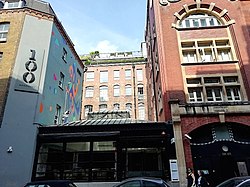 With “Daydream” peaking on the British charts in May of 1966, it can be estimated that Paul and John composed "Good Day Sunshine" at Lennon’s Kenwood home in Weybridge (undoubtedly outside by the pool) in late May or early June of 1966. Although John and George had met The Lovin' Spoonful after that group's April 18th, 1966 show at the Marquee Club in London, John Sebastian wasn't aware for many years that his song inspired this Beatles track. “One of the wonderful things The Beatles had going for them is that they were so original that when they did cop an idea from somebody else it never occurred to you,” John Sebastian explained. “I thought there were one or two of their songs which were Spoonfuloid but it wasn’t until Paul mentioned it in a Playboy interview (in 1984) that I specifically realized we’d inspired ‘Good Day Sunshine.’” With “Daydream” peaking on the British charts in May of 1966, it can be estimated that Paul and John composed "Good Day Sunshine" at Lennon’s Kenwood home in Weybridge (undoubtedly outside by the pool) in late May or early June of 1966. Although John and George had met The Lovin' Spoonful after that group's April 18th, 1966 show at the Marquee Club in London, John Sebastian wasn't aware for many years that his song inspired this Beatles track. “One of the wonderful things The Beatles had going for them is that they were so original that when they did cop an idea from somebody else it never occurred to you,” John Sebastian explained. “I thought there were one or two of their songs which were Spoonfuloid but it wasn’t until Paul mentioned it in a Playboy interview (in 1984) that I specifically realized we’d inspired ‘Good Day Sunshine.’”
Recording History
With the vast majority of the “Revolver” album complete, the group entered EMI Studio Two on June 8th, 1966 at 2:30 pm for what became a full twelve-hour session for recording “Good Day Sunshine” (or “A Good Day’s Sunshine” as it was titled on the tape box). This song was the third from last song recorded for the album.
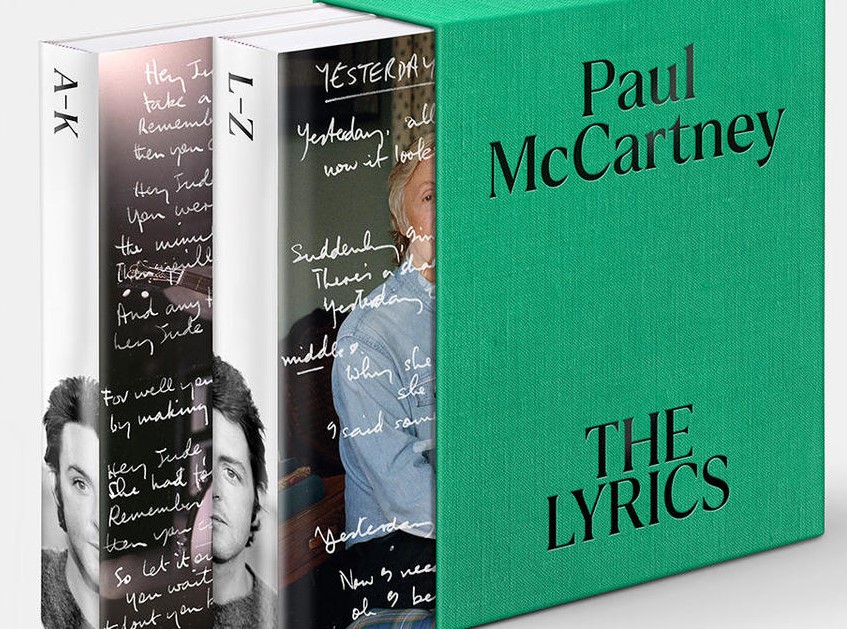 With the tapes rolling, The Beatles spent a long time rehearsing and working out the arrangement of the song. "I have talked to classical composers who puzzle over the time signature," Paul relates in his book "The Lyrics," "but we never laid out the time signature. We just went, 'It goes like this...' Classical (musicians) can't say, 'It goes like this,' because they are invested in formalized notation. They have got to know whether it's 3/4 time or 5/4 or something else - and that was definitely the tradition with all the groups...It's worth recalling that there was no sheet music to look at. It's quite tricky, but our method was just to listen to a song and learn it, and that was where our investment came from. If someone is just reading off the notes - 'one two three, one two three four' - I always feel as if they don't enjoy it as much. It's a job." With the tapes rolling, The Beatles spent a long time rehearsing and working out the arrangement of the song. "I have talked to classical composers who puzzle over the time signature," Paul relates in his book "The Lyrics," "but we never laid out the time signature. We just went, 'It goes like this...' Classical (musicians) can't say, 'It goes like this,' because they are invested in formalized notation. They have got to know whether it's 3/4 time or 5/4 or something else - and that was definitely the tradition with all the groups...It's worth recalling that there was no sheet music to look at. It's quite tricky, but our method was just to listen to a song and learn it, and that was where our investment came from. If someone is just reading off the notes - 'one two three, one two three four' - I always feel as if they don't enjoy it as much. It's a job."
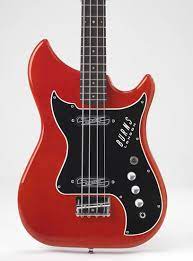 During all of the numbered rehearsal takes that the band recorded, the instrumentation consisted of Paul on piano, George playing his Burns Nu-Sonic bass guitar, Ringo on drums and John on tambourine, all of this allocated onto track one of the four-track tape. There were six earlier takes recorded as they were working out the arrangement, Paul stating after "take five" broke down, "Wow! I came in at about eight on that count-in." "Take six" built up their confidence enough to have the tape spooled back to the beginning in order to get the perfected rhythm track, this next recording being designated "take one." They followed this with two more attempts, "take two" being a false start and "take three" making it through to the end of the song. However, "take one" was deemed the best and therefore used for overdubs. As in other cases during the "Revolver" sessions, the original tape still contains the remaining rehearsal takes they deemed unacceptable. During all of the numbered rehearsal takes that the band recorded, the instrumentation consisted of Paul on piano, George playing his Burns Nu-Sonic bass guitar, Ringo on drums and John on tambourine, all of this allocated onto track one of the four-track tape. There were six earlier takes recorded as they were working out the arrangement, Paul stating after "take five" broke down, "Wow! I came in at about eight on that count-in." "Take six" built up their confidence enough to have the tape spooled back to the beginning in order to get the perfected rhythm track, this next recording being designated "take one." They followed this with two more attempts, "take two" being a false start and "take three" making it through to the end of the song. However, "take one" was deemed the best and therefore used for overdubs. As in other cases during the "Revolver" sessions, the original tape still contains the remaining rehearsal takes they deemed unacceptable.
 The overdubs began immediately, John, Paul and George adding their harmonies in the choruses with McCartney singing lead vocals throughout the rest of the song on track three. By 2:30 am the following morning, the session was complete. The overdubs began immediately, John, Paul and George adding their harmonies in the choruses with McCartney singing lead vocals throughout the rest of the song on track three. By 2:30 am the following morning, the session was complete.
 Twelve hours later, or at 2:30 pm on June 9th, 1966, they returned to EMI Studio Two to put the finishing touches on the song. The next overdub was Ringo playing an additional drum performance on track four, this being done simultaneous to what he recorded on the previous day for the rhythm track. This new drum performance consisted of cymbal crashes, syncopated drum accents, snare beats and stick-tapping, Paul adding a whole new piano part on this track as well that included the boogie-style run heard after the lyric "Then we lie beneath a shady tree." Twelve hours later, or at 2:30 pm on June 9th, 1966, they returned to EMI Studio Two to put the finishing touches on the song. The next overdub was Ringo playing an additional drum performance on track four, this being done simultaneous to what he recorded on the previous day for the rhythm track. This new drum performance consisted of cymbal crashes, syncopated drum accents, snare beats and stick-tapping, Paul adding a whole new piano part on this track as well that included the boogie-style run heard after the lyric "Then we lie beneath a shady tree."
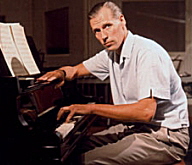 Onto track two was recorded a vaudeville style piano solo performed by George Martin in the instrumental section of the second verse, this being a change from the guitar solo that Paul stipulated in his original lyric sheet for the song. According to Mark Lewisohn's book "The Beatles Recording Sessions," this piano solo was taped at 56 cycles per second (a bit slower than normal) to create an appropriate honky-tonk sound. Various other spots of track two contained all four Beatles performing handclaps. Onto track two was recorded a vaudeville style piano solo performed by George Martin in the instrumental section of the second verse, this being a change from the guitar solo that Paul stipulated in his original lyric sheet for the song. According to Mark Lewisohn's book "The Beatles Recording Sessions," this piano solo was taped at 56 cycles per second (a bit slower than normal) to create an appropriate honky-tonk sound. Various other spots of track two contained all four Beatles performing handclaps.
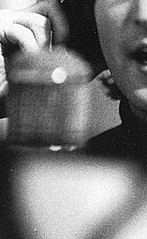 All four tracks were now filled, but it was decided that the song should conclude with some intricate harmonies sung in an overlapping "row, row, row your boat" fashion. Without creating a reduction mix (as most of the "Revolver" songs ended up needing), John, Paul and George recorded some more harmonies onto tracks one, two and four during the final nine seconds of the song. These were all sung strategically starting on different beats so that they could be combined and then faded out in the final mixes. In the process, the piano performance noticeably drops out when the newly recorded harmonies replace it on the track, this being obvious in the released version. All four tracks were now filled, but it was decided that the song should conclude with some intricate harmonies sung in an overlapping "row, row, row your boat" fashion. Without creating a reduction mix (as most of the "Revolver" songs ended up needing), John, Paul and George recorded some more harmonies onto tracks one, two and four during the final nine seconds of the song. These were all sung strategically starting on different beats so that they could be combined and then faded out in the final mixes. In the process, the piano performance noticeably drops out when the newly recorded harmonies replace it on the track, this being obvious in the released version.
 After all of the overdubs were complete, producer George Martin and engineers Geoff Emerick and Phil McDonald created six mono mixes, the first consisting of only the final harmony overdubs they just completed. The remaining five mixes were of the complete song; take six being deemed the best at that time. This mix, however, was to be improved upon at a later date. The recording session then ended at a more reasonable time of 8 pm. After all of the overdubs were complete, producer George Martin and engineers Geoff Emerick and Phil McDonald created six mono mixes, the first consisting of only the final harmony overdubs they just completed. The remaining five mixes were of the complete song; take six being deemed the best at that time. This mix, however, was to be improved upon at a later date. The recording session then ended at a more reasonable time of 8 pm.
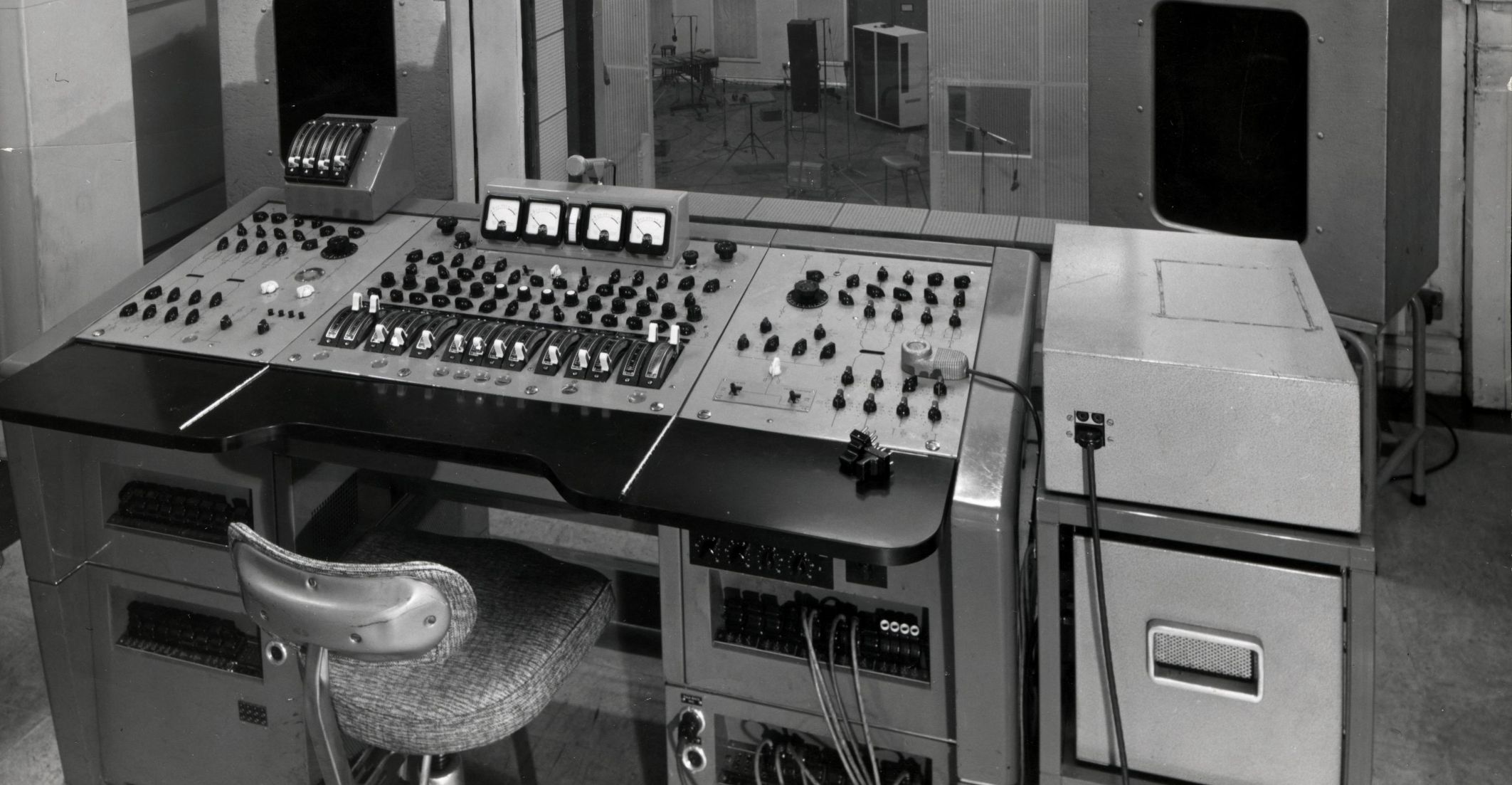 The final day of mixing to complete the album took place on June 22nd, 1966 in the control room of EMI Studio Three. The mono and stereo mixes of “Good Day Sunshine” (the correct title being indicated at this point) were both performed on this day by George Martin and engineers Geoff Emerick and Jerry Boys. The stereo mix has the rhythm track panned to the left channel while the instrumental overdubs are in the right channel. All vocals are centered in the mix except for the ending harmonies which bounce between both channels for good effect. The final day of mixing to complete the album took place on June 22nd, 1966 in the control room of EMI Studio Three. The mono and stereo mixes of “Good Day Sunshine” (the correct title being indicated at this point) were both performed on this day by George Martin and engineers Geoff Emerick and Jerry Boys. The stereo mix has the rhythm track panned to the left channel while the instrumental overdubs are in the right channel. All vocals are centered in the mix except for the ending harmonies which bounce between both channels for good effect.
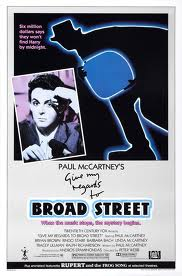 Sometime between November 1982 and July 1983, Paul re-recorded a new studio version of the song "Good Day Sunshine" for inclusion in the movie and soundtrack album for “Give My Regards To Broad Street.” The arrangement was nearly identical to the original, right down to mimicking John’s quietly repeated line “she do!” in the final verse. One subtle difference lyrically is the line “burns my feel as I touch the ground” instead of “as they touch the ground” as sung in 1966. Paul was privileged to have George Martin as producer of this version as well as the original. Sometime between November 1982 and July 1983, Paul re-recorded a new studio version of the song "Good Day Sunshine" for inclusion in the movie and soundtrack album for “Give My Regards To Broad Street.” The arrangement was nearly identical to the original, right down to mimicking John’s quietly repeated line “she do!” in the final verse. One subtle difference lyrically is the line “burns my feel as I touch the ground” instead of “as they touch the ground” as sung in 1966. Paul was privileged to have George Martin as producer of this version as well as the original.
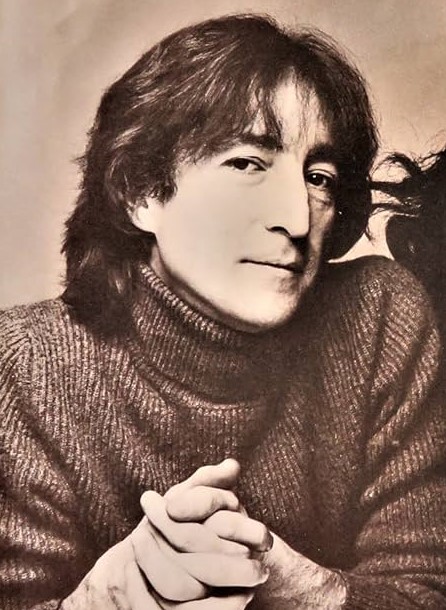 McCartney’s “World Tour” of 1989/1990 also included the song, resulting in it being recorded and released as the b-side of the live version of “Birthday” to commemorate John Lennon’s 50th birthday. Surprisingly, this live version of “Good Day Sunshine” did not appear on the resulting “Tripping The Live Fantastic” album of November, 1990. McCartney’s “World Tour” of 1989/1990 also included the song, resulting in it being recorded and released as the b-side of the live version of “Birthday” to commemorate John Lennon’s 50th birthday. Surprisingly, this live version of “Good Day Sunshine” did not appear on the resulting “Tripping The Live Fantastic” album of November, 1990.
 Sometime in 2022, George Martin's son Giles Martin, along with engineer Sam Okell, returned to the original four-track tape of "Good Day Sunshine" in order to create a vibrant new stereo mix for inclusion in the various new releases of the album "Revolver." New AI technology was used to separate the recorded elements for panning them accordingly for a more enjoyable stereo experience. Sometime in 2022, George Martin's son Giles Martin, along with engineer Sam Okell, returned to the original four-track tape of "Good Day Sunshine" in order to create a vibrant new stereo mix for inclusion in the various new releases of the album "Revolver." New AI technology was used to separate the recorded elements for panning them accordingly for a more enjoyable stereo experience.
Song Structure and Style
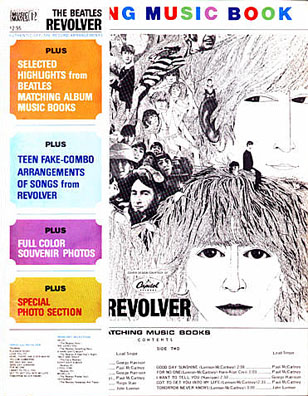 The structure utilized here on this track stretches the boundaries in many ways from what we’re used to hearing in Beatles music. One way is the use of a chorus at the beginning of the song, this being in a different key than the verse (the verse key being designated as the signature key of the song). The complete song structure amounts to ‘chorus/ verse/ chorus/ 1/2 verse/ solo/ chorus/ verse/ chorus/ chorus’ (or abacdabaa). A simple introduction and faded conclusion round out the proceedings. Many other twists and turns can be detected within the boundaries of these two minutes and eight seconds. The structure utilized here on this track stretches the boundaries in many ways from what we’re used to hearing in Beatles music. One way is the use of a chorus at the beginning of the song, this being in a different key than the verse (the verse key being designated as the signature key of the song). The complete song structure amounts to ‘chorus/ verse/ chorus/ 1/2 verse/ solo/ chorus/ verse/ chorus/ chorus’ (or abacdabaa). A simple introduction and faded conclusion round out the proceedings. Many other twists and turns can be detected within the boundaries of these two minutes and eight seconds.
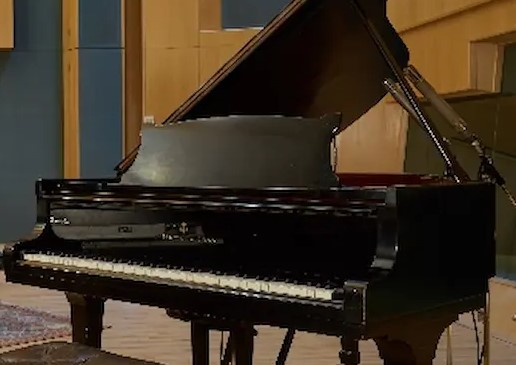 The four-measure intro is actually the simplest section of the song, consisting of eighth-note E major chords played on piano and bass guitar building in anticipation of what is to follow. This appears to be establishing the footing for the listener to be ready for the complex chorus that follows. The fourth measure of the intro brings triplet rolls of the snare drum along with an abrupt overdubbed cymbal swell to signal the emergence of that first chorus, this entire intro appropriately portraying the sudden burst of light from a bright new sunrise. The four-measure intro is actually the simplest section of the song, consisting of eighth-note E major chords played on piano and bass guitar building in anticipation of what is to follow. This appears to be establishing the footing for the listener to be ready for the complex chorus that follows. The fourth measure of the intro brings triplet rolls of the snare drum along with an abrupt overdubbed cymbal swell to signal the emergence of that first chorus, this entire intro appropriately portraying the sudden burst of light from a bright new sunrise.
 Three part harmony from Paul, John and George begins on the downbeat of the chorus, this being a straight six measures in length. Because of the slow syncopation of the melody line and the stagnation of the chord changes, it appears that the measures aren’t symmetrical but broken into different time signatures. This is an illusion. If you keep time to the beat as established in the introduction, keep tapping your foot in the same 4/4 pattern throughout the chorus and you’ll see that the time signature hasn’t really changed. A further twist is that the key of the song appears to be in B major at this point. However, the transitional chord E7 in the fifth and sixth measures shows that the key has yet to be determined. Three part harmony from Paul, John and George begins on the downbeat of the chorus, this being a straight six measures in length. Because of the slow syncopation of the melody line and the stagnation of the chord changes, it appears that the measures aren’t symmetrical but broken into different time signatures. This is an illusion. If you keep time to the beat as established in the introduction, keep tapping your foot in the same 4/4 pattern throughout the chorus and you’ll see that the time signature hasn’t really changed. A further twist is that the key of the song appears to be in B major at this point. However, the transitional chord E7 in the fifth and sixth measures shows that the key has yet to be determined.
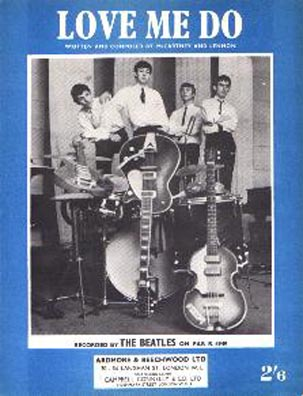 The traditional use of a "Beatles break" (first heard way back in 1962’s “Love Me Do”) appears at the end of the sixth measure of the chorus to highlight Paul’s lyric “I need to laugh.” This segues into the first eight-measure verse and hereby first reveals the signature key of the song – A major. The drums then switch from the march-like quarter-note snare beats to a regular-but-simplistic swing beat, the overdubbed piano from Paul playing a falling riff to fill the gap after the first lyric is sung. Paul sings the verse solo as contrast to the gorgeous harmonies in the choruses. The traditional use of a "Beatles break" (first heard way back in 1962’s “Love Me Do”) appears at the end of the sixth measure of the chorus to highlight Paul’s lyric “I need to laugh.” This segues into the first eight-measure verse and hereby first reveals the signature key of the song – A major. The drums then switch from the march-like quarter-note snare beats to a regular-but-simplistic swing beat, the overdubbed piano from Paul playing a falling riff to fill the gap after the first lyric is sung. Paul sings the verse solo as contrast to the gorgeous harmonies in the choruses.
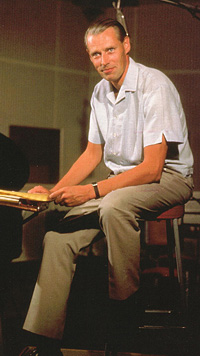 The chorus is then repeated, the only difference being Ringo's overdubbed drum track with his syncopated crashing cymbals accenting each sung syllable and a quaint snare drum cadence to fill in each gap. After this chorus is complete, what appears to be a second verse then appears with the same arrangement as the first. However, midway through, after the vocal line “touch the ground,” the key pivots to D major for a George Martin piano solo. The chord pattern may have changed, but the remaining four measures of this pseudo-verse are filled with this solo to equal a uniform eight measure length. The chorus is then repeated, the only difference being Ringo's overdubbed drum track with his syncopated crashing cymbals accenting each sung syllable and a quaint snare drum cadence to fill in each gap. After this chorus is complete, what appears to be a second verse then appears with the same arrangement as the first. However, midway through, after the vocal line “touch the ground,” the key pivots to D major for a George Martin piano solo. The chord pattern may have changed, but the remaining four measures of this pseudo-verse are filled with this solo to equal a uniform eight measure length.
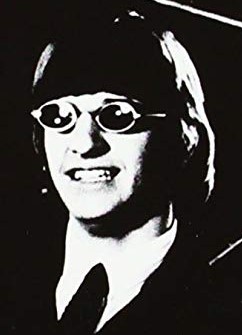 A third chorus is then revealed, complete with the overdubbed drums as heard in the previous one. This is followed by a full vocal verse as was heard toward the beginning of the song only with new lyrics. The only difference in arrangement is the appearance of handclaps on the two- and four-beats of each measure, not to mention John’s voice being heard saying "She do!" after Paul's line “she feels good” in the fifth measure. The rather obvious edit on the overdubbed piano track in the eighth measure completes the final verse. A third chorus is then revealed, complete with the overdubbed drums as heard in the previous one. This is followed by a full vocal verse as was heard toward the beginning of the song only with new lyrics. The only difference in arrangement is the appearance of handclaps on the two- and four-beats of each measure, not to mention John’s voice being heard saying "She do!" after Paul's line “she feels good” in the fifth measure. The rather obvious edit on the overdubbed piano track in the eighth measure completes the final verse.
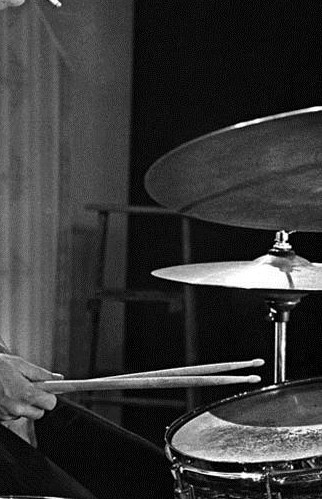 Two more choruses follow this verse, both adding the new feature of quarter-note hand claps performed by the whole group. Both choruses are actually one beat short because of the absence of the "Beatles break," making the final measure 3/4 instead of 4/4. The second of these two choruses reveals a slight deviation from the original melody line, Paul raising the notes for “sun-shine” the first two times the word is sung. Then as the second chorus is complete, the key raises a half step to an F7 chord for a brief faded conclusion. The overdubbed cymbal crash cuts off abruptly to allow space on the tape for more three-part harmonies which are sung in echo of the original line. All instrumentation fades away to reveal a cappella Beatles harmonies from both channels of your speakers. An impressive touch. Two more choruses follow this verse, both adding the new feature of quarter-note hand claps performed by the whole group. Both choruses are actually one beat short because of the absence of the "Beatles break," making the final measure 3/4 instead of 4/4. The second of these two choruses reveals a slight deviation from the original melody line, Paul raising the notes for “sun-shine” the first two times the word is sung. Then as the second chorus is complete, the key raises a half step to an F7 chord for a brief faded conclusion. The overdubbed cymbal crash cuts off abruptly to allow space on the tape for more three-part harmonies which are sung in echo of the original line. All instrumentation fades away to reveal a cappella Beatles harmonies from both channels of your speakers. An impressive touch.
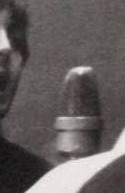 Paul, no doubt with the help of George Martin, is in full control of proceedings. His vocal work is deliberate and focused, creating the desired atmosphere. His dual piano tracks are also suitable for the occasion but not too flamboyant so as to distract from the harmonies. Three cheers also go to George Martin for his always-appropriate piano solo and arrangement of harmonies. Paul, no doubt with the help of George Martin, is in full control of proceedings. His vocal work is deliberate and focused, creating the desired atmosphere. His dual piano tracks are also suitable for the occasion but not too flamboyant so as to distract from the harmonies. Three cheers also go to George Martin for his always-appropriate piano solo and arrangement of harmonies.
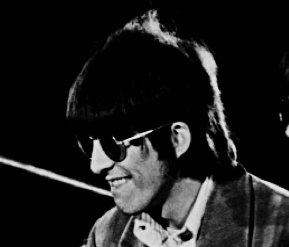 George Harrison shows himself adept at bass guitar as well as with his spot-on harmony vocals. John Lennon’s distinctive voice is also quite apparent on the track, his delivery flawless. Ringo Starr goes over and above with not one but two drum tracks superimposed on top of each other to good effect. George Harrison shows himself adept at bass guitar as well as with his spot-on harmony vocals. John Lennon’s distinctive voice is also quite apparent on the track, his delivery flawless. Ringo Starr goes over and above with not one but two drum tracks superimposed on top of each other to good effect.
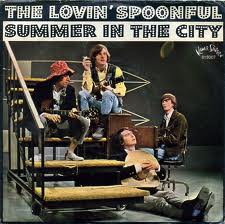 This song's happy-go-lucky lyrics are quite self-explanatory, the heaviness of the times leaving the singer with a “need to laugh,” a “sunny day” giving him just the fix he needs. Of course, being “in love” also helps. The Lovin’ Spoonful's current hit at the time of release, “Summer In The City,” may have expressed irritation because of the hot weather, but Paul doesn’t mind that the sun ‘burns his feet as they touch the ground.’ After all, he and his woman will find relief “beneath a shady tree” making love. A touch of conceit is made apparent in the line “she knows she’s looking fine,” but that doesn’t spoil the mood one bit as he finishes off the lyric with “I’m so proud to know that she is mine.” It’s summer in London and all is right with the world! This song's happy-go-lucky lyrics are quite self-explanatory, the heaviness of the times leaving the singer with a “need to laugh,” a “sunny day” giving him just the fix he needs. Of course, being “in love” also helps. The Lovin’ Spoonful's current hit at the time of release, “Summer In The City,” may have expressed irritation because of the hot weather, but Paul doesn’t mind that the sun ‘burns his feet as they touch the ground.’ After all, he and his woman will find relief “beneath a shady tree” making love. A touch of conceit is made apparent in the line “she knows she’s looking fine,” but that doesn’t spoil the mood one bit as he finishes off the lyric with “I’m so proud to know that she is mine.” It’s summer in London and all is right with the world!
American Releases
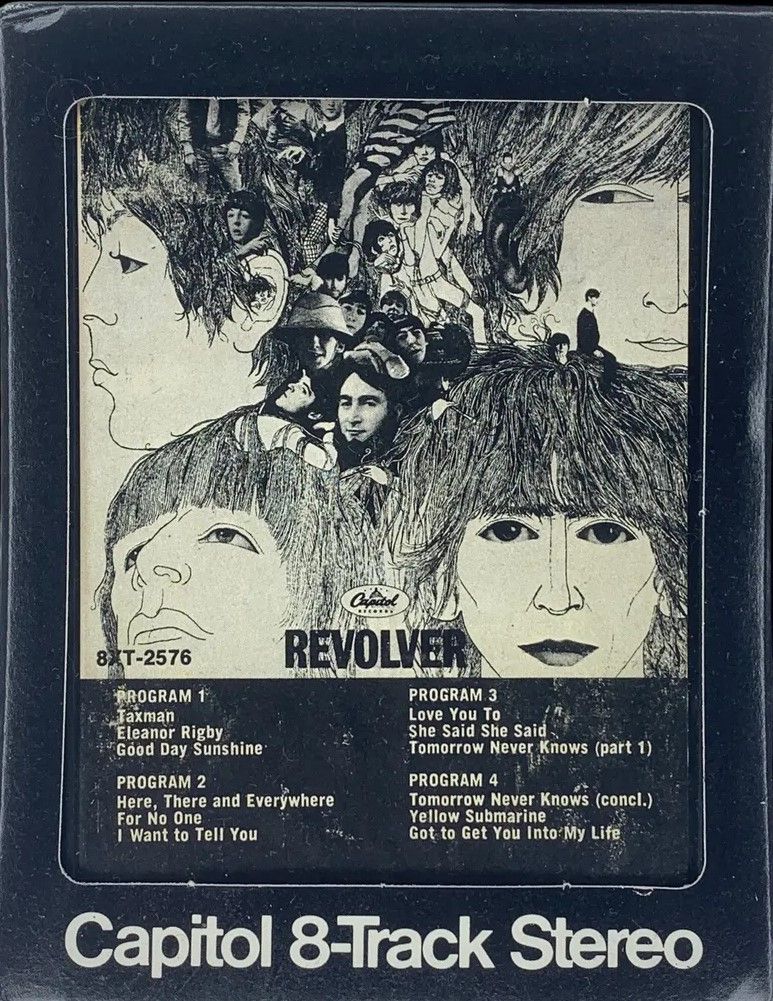 On August 8th, 1966, the eleven track “Revolver” album was released in the US, side two beginning with "Good Day Sunshine." Its happy irresistibility secured it much airplay on American radio stations at the time, this trend continuing on oldies stations to this day. The American version of the "Revolver" album got a compact disc release on January 21st, 2014, both the mono and stereo versions contained on a single CD. On August 8th, 1966, the eleven track “Revolver” album was released in the US, side two beginning with "Good Day Sunshine." Its happy irresistibility secured it much airplay on American radio stations at the time, this trend continuing on oldies stations to this day. The American version of the "Revolver" album got a compact disc release on January 21st, 2014, both the mono and stereo versions contained on a single CD.
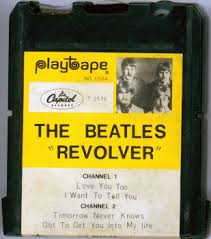 Sometime in 1967, Capitol released Beatles music on a brand new but short-lived format called "Playtapes." These tape cartridges did not have the capability of including entire albums, so two four-song versions of "Revolver" came out in this portable format, "Good Day Sunshine" being on one of them. These "Playtapes" are highly collectable today. Sometime in 1967, Capitol released Beatles music on a brand new but short-lived format called "Playtapes." These tape cartridges did not have the capability of including entire albums, so two four-song versions of "Revolver" came out in this portable format, "Good Day Sunshine" being on one of them. These "Playtapes" are highly collectable today.
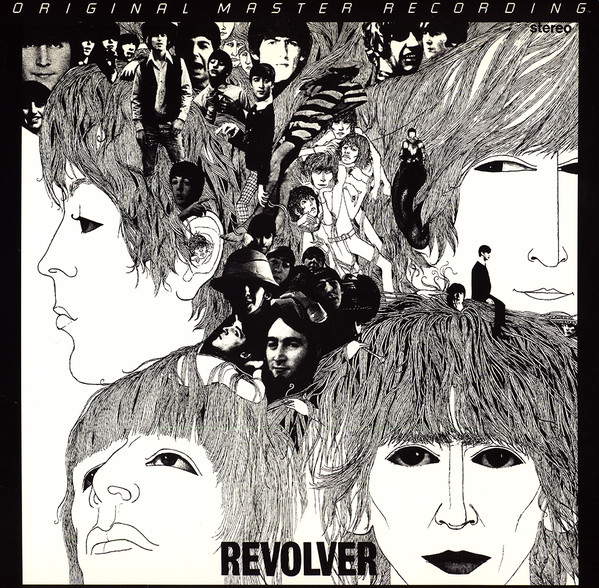 The first time the original British "Revolver” album was made available in the US was the "Original Master Recording" vinyl edition released through Mobile Fidelity Sound Lab sometime in 1985. This album included "Good Day Sunshine" and was prepared utilizing half-speed mastering technology from the original master tape on loan from EMI. This version of the album was only available for a short time and is quite collectible today. The first time the original British "Revolver” album was made available in the US was the "Original Master Recording" vinyl edition released through Mobile Fidelity Sound Lab sometime in 1985. This album included "Good Day Sunshine" and was prepared utilizing half-speed mastering technology from the original master tape on loan from EMI. This version of the album was only available for a short time and is quite collectible today.
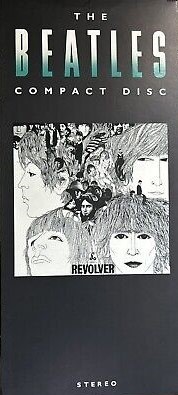 April 30th, 1987 was the date of the US compact disc release of the British "Revolver" album, a vinyl edition coming out on July 21st, 1987. The album was then remastered and re-released on CD on September 9th, 2009 and then on vinyl on November 13th, 2012. A remarkable newly mixed edition of "Revolver" created by Giles Martin was released on vinyl and CD on October 28th, 2022. April 30th, 1987 was the date of the US compact disc release of the British "Revolver" album, a vinyl edition coming out on July 21st, 1987. The album was then remastered and re-released on CD on September 9th, 2009 and then on vinyl on November 13th, 2012. A remarkable newly mixed edition of "Revolver" created by Giles Martin was released on vinyl and CD on October 28th, 2022.
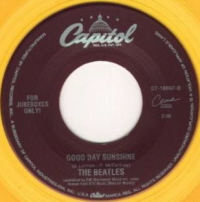 Although not originally released as a single, it did get released as such on January 24th, 1996 as the b-side to another Paul McCartney “Revolver” track, “Here, There And Everywhere.” This 45 was on Capitol’s Cema series “For Jukeboxes Only” and was printed on yellow vinyl. Although not originally released as a single, it did get released as such on January 24th, 1996 as the b-side to another Paul McCartney “Revolver” track, “Here, There And Everywhere.” This 45 was on Capitol’s Cema series “For Jukeboxes Only” and was printed on yellow vinyl.
The original 1966 mono mix was made available once again as part of the remastered “The Beatles In Mono” box set. The CD edition of this box set came out on September 9th, 2009, while the vinyl edition was first released on September 9th, 2014.
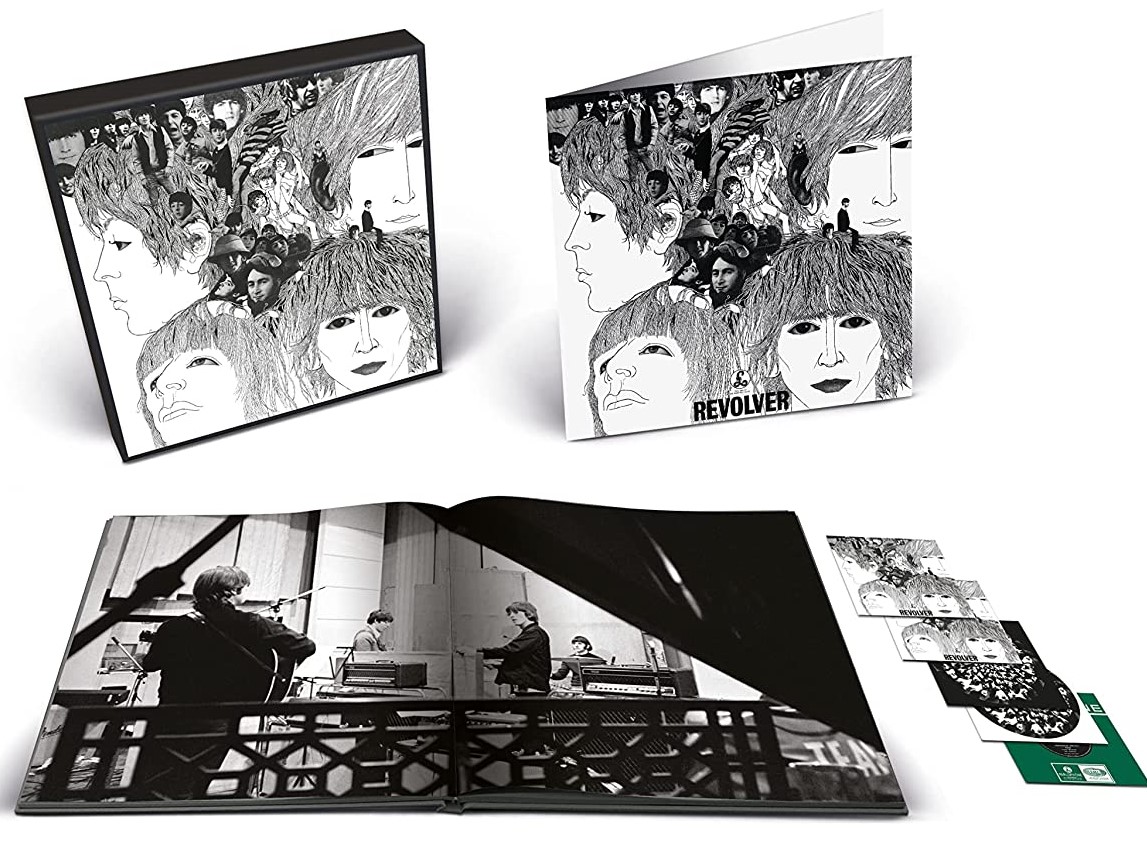 On October 28th, 2022, various new editions of the 14 track “Revolver” album were released that feature the amazing new stereo mix by Giles Martin. The “Special Edition Deluxe 2CD Set” features the song “Good Day Sunshine” in its new stereo mix. The “Deluxe Edition,” available as a 5 CD box set and as a 4LP / 1 EP box set, also includes the 1966 mono master. The 2022 Giles Martin stereo mix of the album was also made available for the first time as a vinyl picture disc for a limited time. On October 28th, 2022, various new editions of the 14 track “Revolver” album were released that feature the amazing new stereo mix by Giles Martin. The “Special Edition Deluxe 2CD Set” features the song “Good Day Sunshine” in its new stereo mix. The “Deluxe Edition,” available as a 5 CD box set and as a 4LP / 1 EP box set, also includes the 1966 mono master. The 2022 Giles Martin stereo mix of the album was also made available for the first time as a vinyl picture disc for a limited time.
As stated above, Paul re-recorded another studio version of the song for inclusion in the film and soundtrack album “Give My Regards To Broad Street.” This album was released on October 22nd, 1984.
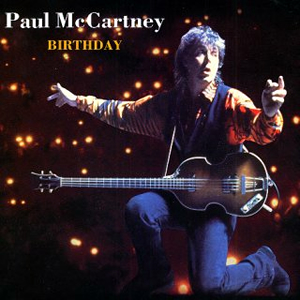 On October 29th, 1990, Paul released a live recording of “Good Day Sunshine” as the b-side of “Birthday,” which was later featured on his live album “Tripping The Live Fantastic.” The single, which was also made available as a CD-single with two bonus tracks, was released to coincide with what would have been John Lennon’s 50th birthday (near enough anyway). On October 29th, 1990, Paul released a live recording of “Good Day Sunshine” as the b-side of “Birthday,” which was later featured on his live album “Tripping The Live Fantastic.” The single, which was also made available as a CD-single with two bonus tracks, was released to coincide with what would have been John Lennon’s 50th birthday (near enough anyway).
Live Performances
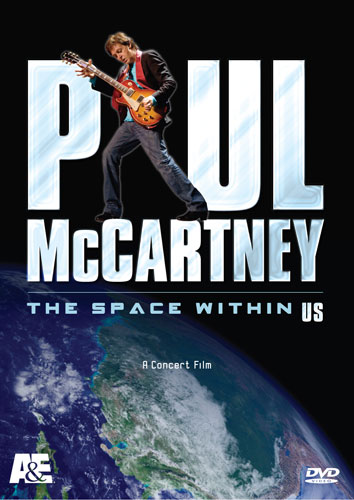 The Beatles may not have touched the song on stage, but the popularity of the track gave Paul license to periodically include it in his live set lists. His first solo “World Tour” of 1989/1990 included the song in its set list, this tour running from September 26th, 1989 to July 29th, 1990. He gave it a rest until his “The ‘US’ Tour,” which ran from September 16th to November 30th, 2005. This tour, featuring the live performance of “Good Day Sunshine,” was featured in the DVD release “The Space Within US." He then worked it back into his set list during some of the 2015 dates of his "Out There" Tour, which spanned from April 15th to October 22nd of that year. The Beatles may not have touched the song on stage, but the popularity of the track gave Paul license to periodically include it in his live set lists. His first solo “World Tour” of 1989/1990 included the song in its set list, this tour running from September 26th, 1989 to July 29th, 1990. He gave it a rest until his “The ‘US’ Tour,” which ran from September 16th to November 30th, 2005. This tour, featuring the live performance of “Good Day Sunshine,” was featured in the DVD release “The Space Within US." He then worked it back into his set list during some of the 2015 dates of his "Out There" Tour, which spanned from April 15th to October 22nd of that year.
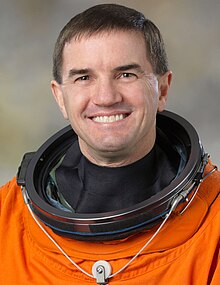 Interestingly, "Good Day Sunshine" was priviledged to be chosen by NASA on three different Space Shuttle flights as a wake up call to their crew. Topping this, on November 3rd, 2005 during Paul's Arrowhead Pond concert in Anaheim, California as part of the above mentioned "'US' Tour," the song was played in a unique link-up to a very special audience. As detailed in Kevin Howlett's liner notes in the 2022 Deluxe editions of "Revolver," "Good Day Sunshine" was played live by McCartney's band "to the Expedition 12 crew aboard the International Space Station...On Day 8 of the 135th and final Space Shuttle flight, the four crew members were roused by a live verison from Paul followed by a recorded message: 'Good morning, guys! Wake up and good luck on this your last mission. Well done.' Mission specialist Rex Walheim thanked Paul for his good wishes and observed that, 'People all around the Earth love Paul McCartney's music and, boy, you can rest assured that people all above the Earth love this music too.'" Interestingly, "Good Day Sunshine" was priviledged to be chosen by NASA on three different Space Shuttle flights as a wake up call to their crew. Topping this, on November 3rd, 2005 during Paul's Arrowhead Pond concert in Anaheim, California as part of the above mentioned "'US' Tour," the song was played in a unique link-up to a very special audience. As detailed in Kevin Howlett's liner notes in the 2022 Deluxe editions of "Revolver," "Good Day Sunshine" was played live by McCartney's band "to the Expedition 12 crew aboard the International Space Station...On Day 8 of the 135th and final Space Shuttle flight, the four crew members were roused by a live verison from Paul followed by a recorded message: 'Good morning, guys! Wake up and good luck on this your last mission. Well done.' Mission specialist Rex Walheim thanked Paul for his good wishes and observed that, 'People all around the Earth love Paul McCartney's music and, boy, you can rest assured that people all above the Earth love this music too.'"
Conclusion
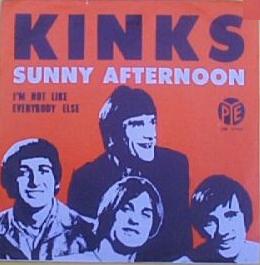 When all is said and done, who can resist a catchy "feel good" song? When the irresistibly folksy swing of The Lovin’ Spoonful’s “Daydream” hit the airwaves in mid 1966, it not only set the tone for a "groovy" summer, but it inspired many songwriters and recording artists to catch that same vibe. The Kinks immediately followed suit with the humorous “Sunny Afternoon,” Donovan captured that atmosphere with “Sunshine Superman,” and then The Beatles one-upped them all with “Good Day Sunshine.” As Chris Ingham describes the song in “The Rough Guide To The Beatles,” it exemplifies that smiling essence “and still manages to pack in more time and key changes than most groups would bother with on an entire album.” Three cheers to The Beatles for putting the exclamation mark on the happy-go-lucky summer of 1966! When all is said and done, who can resist a catchy "feel good" song? When the irresistibly folksy swing of The Lovin’ Spoonful’s “Daydream” hit the airwaves in mid 1966, it not only set the tone for a "groovy" summer, but it inspired many songwriters and recording artists to catch that same vibe. The Kinks immediately followed suit with the humorous “Sunny Afternoon,” Donovan captured that atmosphere with “Sunshine Superman,” and then The Beatles one-upped them all with “Good Day Sunshine.” As Chris Ingham describes the song in “The Rough Guide To The Beatles,” it exemplifies that smiling essence “and still manages to pack in more time and key changes than most groups would bother with on an entire album.” Three cheers to The Beatles for putting the exclamation mark on the happy-go-lucky summer of 1966!
“Good Day Sunshine”
Written by: John Lennon / Paul McCartney
-
Song Written: May / June, 1966
-
Song Recorded: June 8 & 9, 1966
-
First US Release Date: August 8, 1966
-
First US Album Release: Capitol #ST-2576 “Revolver”
-
US Single Release: Capitol Cema #S7-18897
-
Highest Chart Position: n/a
-
British Album Release: Parlophone #PCS 7009 “Revolver”
-
Length: 2:08
-
Key: A major
-
Producer: George Martin
-
Engineers: Geoff Emerick, Richard Lush, Phil McDonald
Instrumentation (most likely):
-
Paul McCartney -- Lead and Harmony Vocals, Piano (Hamburg Steinway Baby Grand),handclaps
-
George Harrison – Bass Guitar (1965 Burns Nu-Sonic), Harmony Vocals, handclaps
-
Ringo Starr – Drums (1964 Ludwig Super Classic Black Oyster Pearl), handclaps
-
John Lennon - Harmony Vocals, tambourine, handclaps
-
George Martin - Piano (Hamburg Steinway Baby Grand)
Written and compiled by Dave Rybaczewski
|
IF YOU WOULD LIKE TO MAKE A DONATION TO KEEP THIS WEBSITE UP AND RUNNING, PLEASE CLICK BELOW!
Sign Up Below for our MONTHLY BEATLES TRIVIA QUIZ!
|